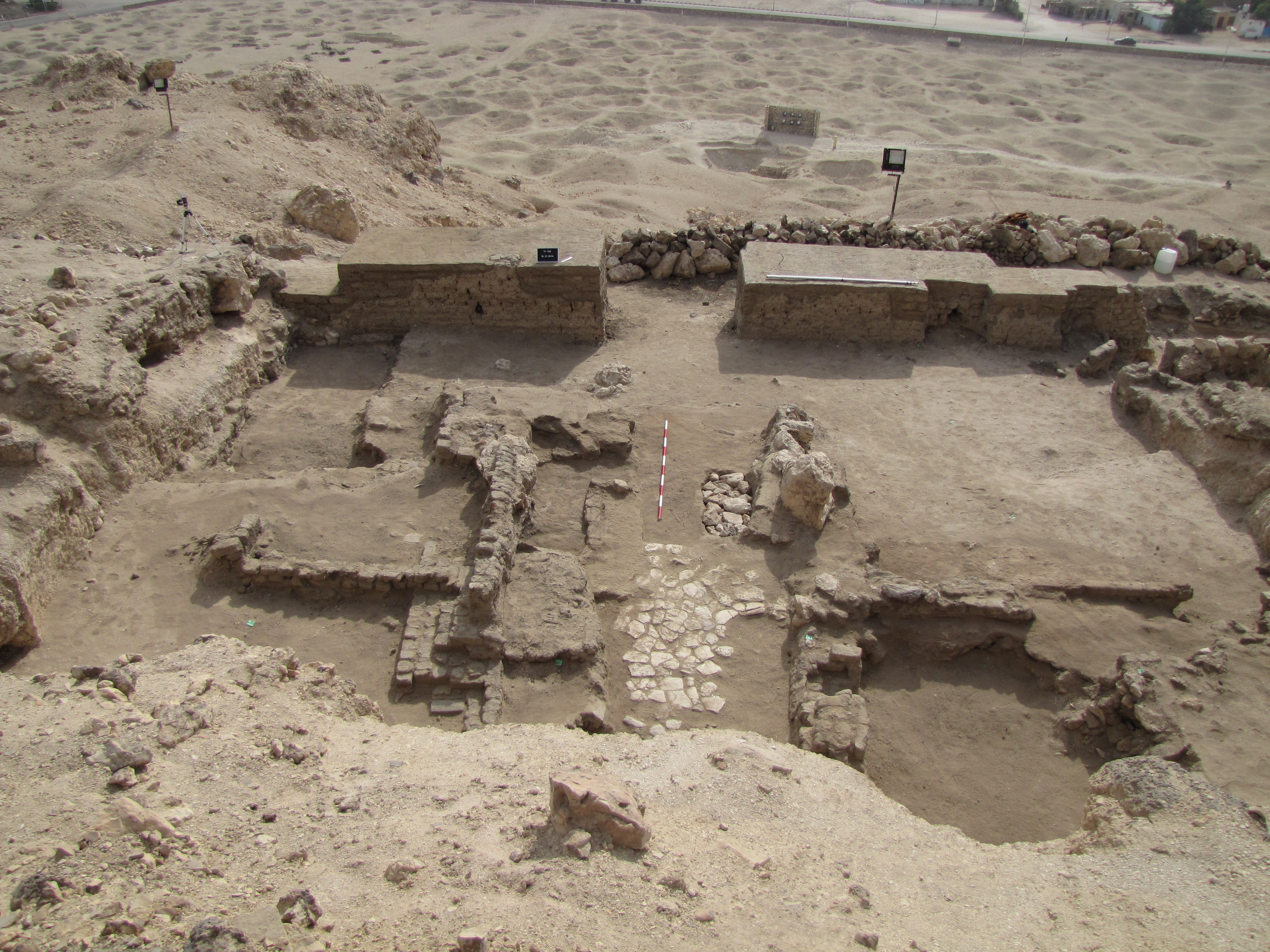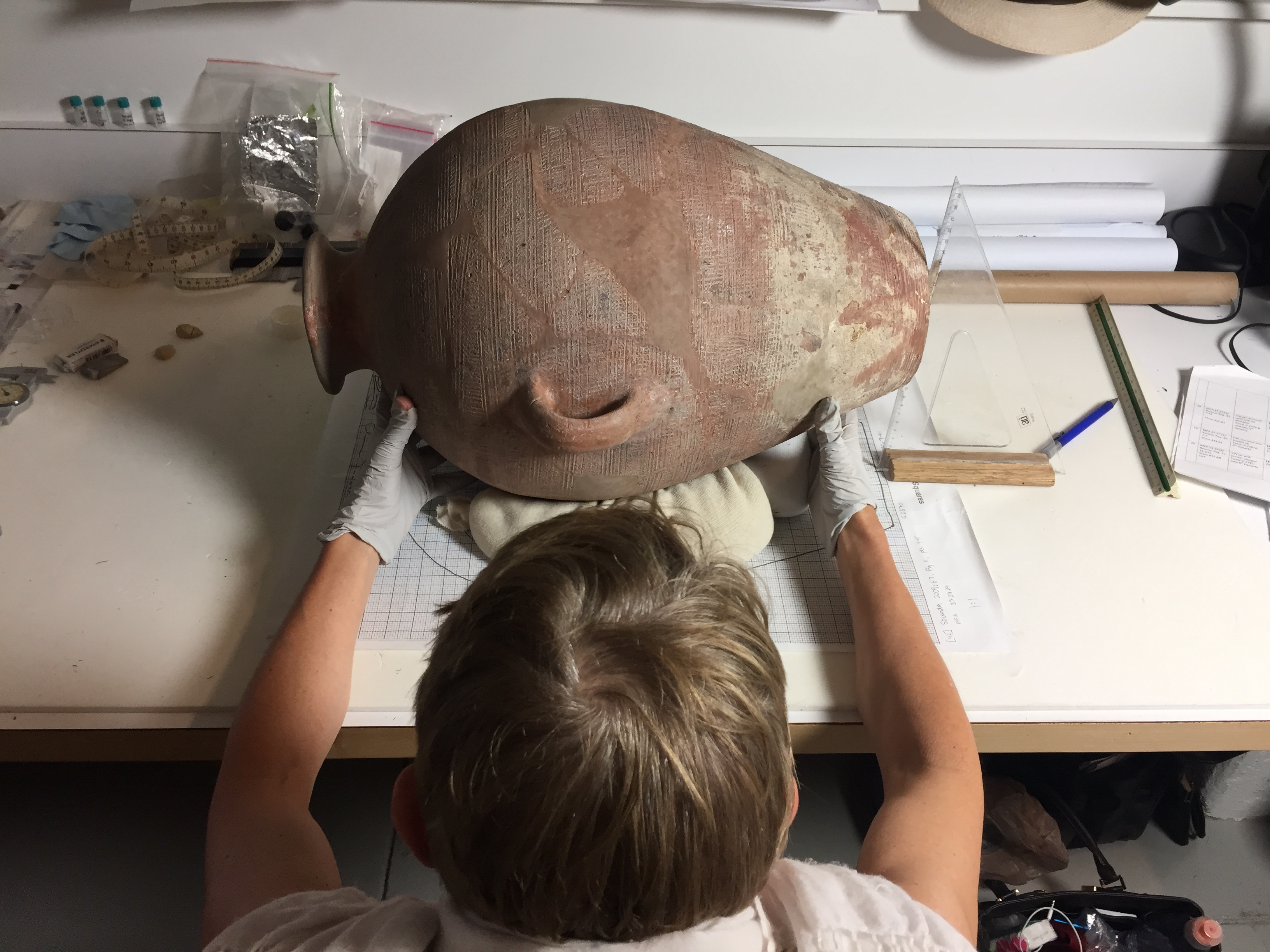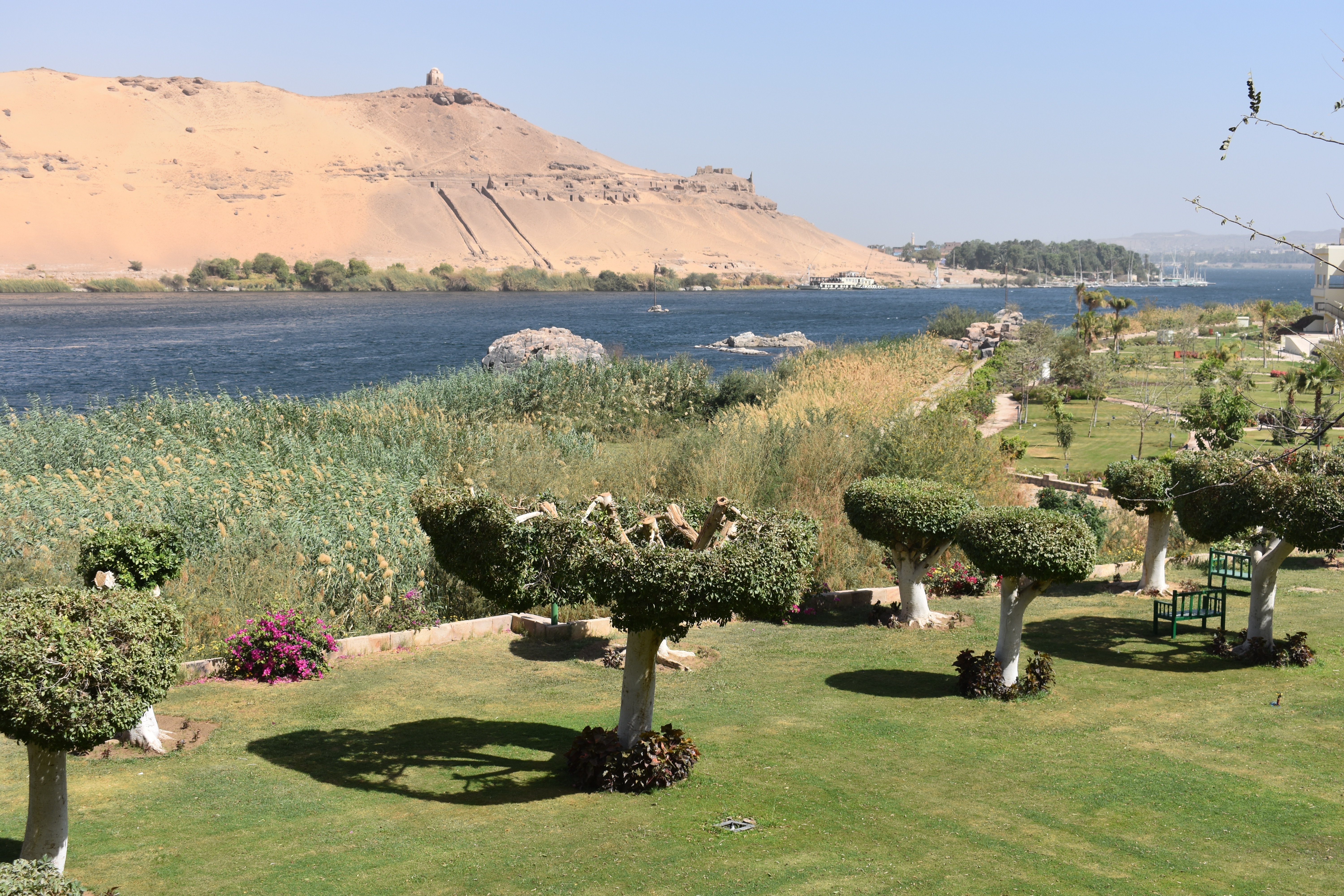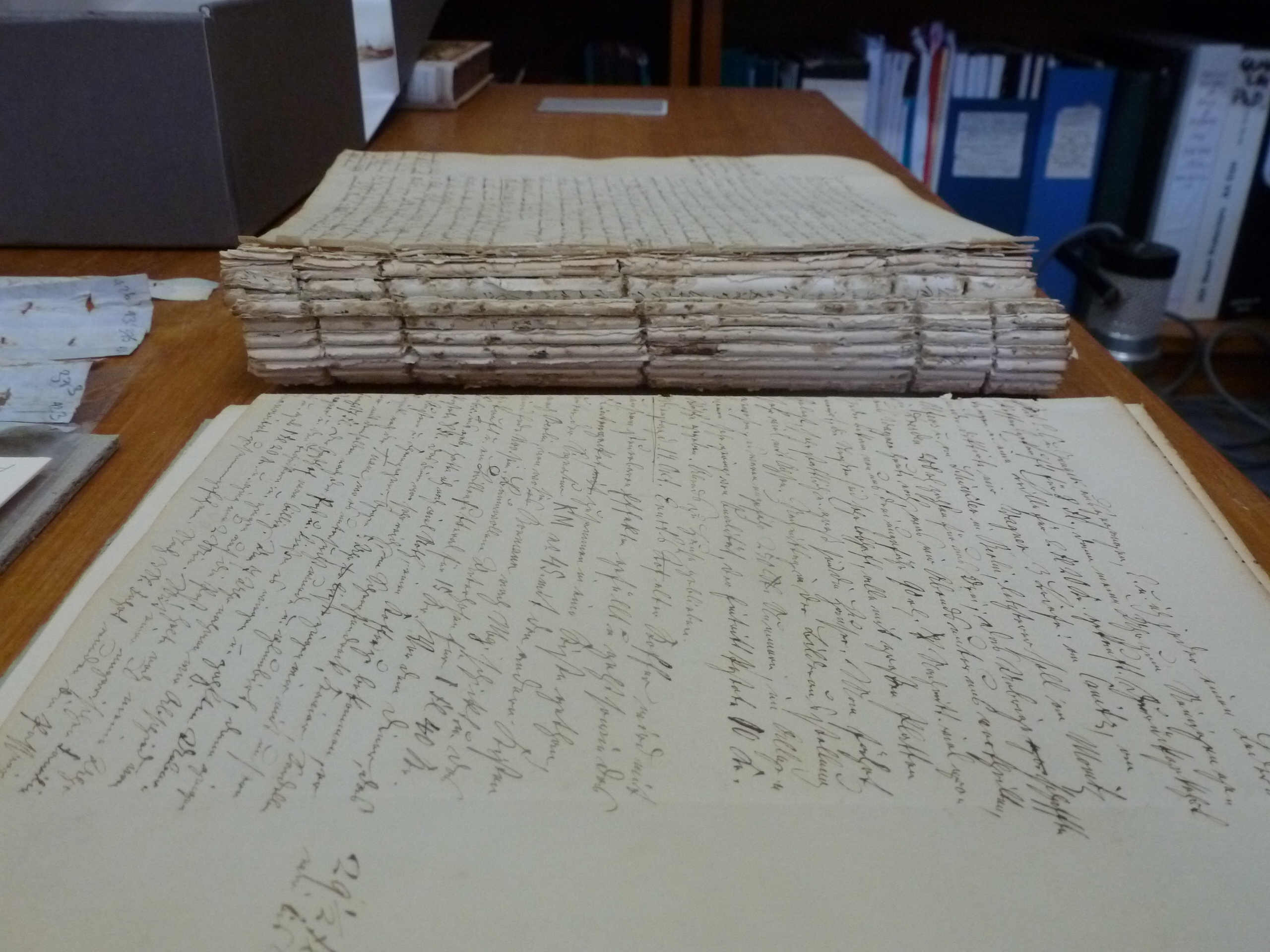Our projects

The Australian Centre for Egyptology supports fieldwork at important sites across Egypt and the research projects of its Members. This page profiles the work currently conducted by these teams.
Key research topics include:
- Understanding ancient Egyptian people and society through fieldwork on selected archaeological sites in Egypt.
- Networks of ancient trade and the role of Egypt in the eastern Mediterranean.
- The history of exploration and museum collections through studies of modern archives.
- Life and death in ancient Egypt through the study of its material culture, burial practices, and the use of science.
List of current projects
See information about all our current projects below:
Antiquity in the Archive: Rediscovering Beni Hassan in the Griffith Institute Archive, Oxford University
Collaborators: Alex Woods, Sara Hany Abed, Julia Hamilton, Nicolle Leary
This collaborative project between the Griffith Institute Archive (GIA), University of Oxford, and Macquarie University will digitally document, catalogue, index and contextualise the 260 archive materials captured during the Egypt Exploration Fund’s late 19th century survey of the ancient cemetery of Beni Hassan in Egypt.
The project aims to critique the development of an archaeological archive through the digitisation of Beni Hassan. Instead of seeing the archive as a “source” of documentation on Egypt in Antiquity, the project will view the archive as "subject" and will treat the documentation itself as an historical artefact with complex conditions of production and as an instrument of colonial and institutional power.
The archive, published in online fora as a bi-lingual resource (English and Arabic), will make the content accessible to an international audience and publicise the archive's cultural legacy.

Image caption: Photograph of a mounted watercolour. Drawn and measured on site by John E. Newberry, January 1893. The watercolour depicts a representative sample of the frieze and geometric pattern in the barrel-vault ceiling in the tomb of Khnumhotep II, Tomb 3, Beni Hassan, Egypt (GI-WD-scenes-100). Photo: A. Woods. © The Griffith Institute, University of Oxford. Reproduced with permission.
Funding source
Macquarie University Research Acceleration Scheme (Round 1, 2022)
Impacts of Instability: Funerary Models, Wall Scenes and Inscriptions at Asyut
Georgia Barker
Through a case study of the cemetery of Asyut, this project aims to determine how a period of political instability affected funerary customs during the First Intermediate Period and early Middle Kingdom in Egypt (c. 2160–1938 BC).
The military holds a prominent place in the inscriptions and representations in the tombs at Asyut, reflecting a growing feeling of instability and the critical role the province played in the civil war. Notably, this theme remains dominant in the sources after the re-unification of the country in the Middle Kingdom.
While the historical importance of the inscriptions has been investigated by scholars, the complementary artistic sources have not been adequately assessed. This project, therefore, comprises the first comparative analysis of the three primary artistic and textual sources found at the site: funerary models, wall scenes and inscriptions.
This analysis aims to highlight the historical importance of artistic representations and to provide new insight into the impact of the turbulent period on the individuals of the region.
Funding period
1 January – 31 December 2022
Funding source
Macquarie University, COVID Recovery Fellowship
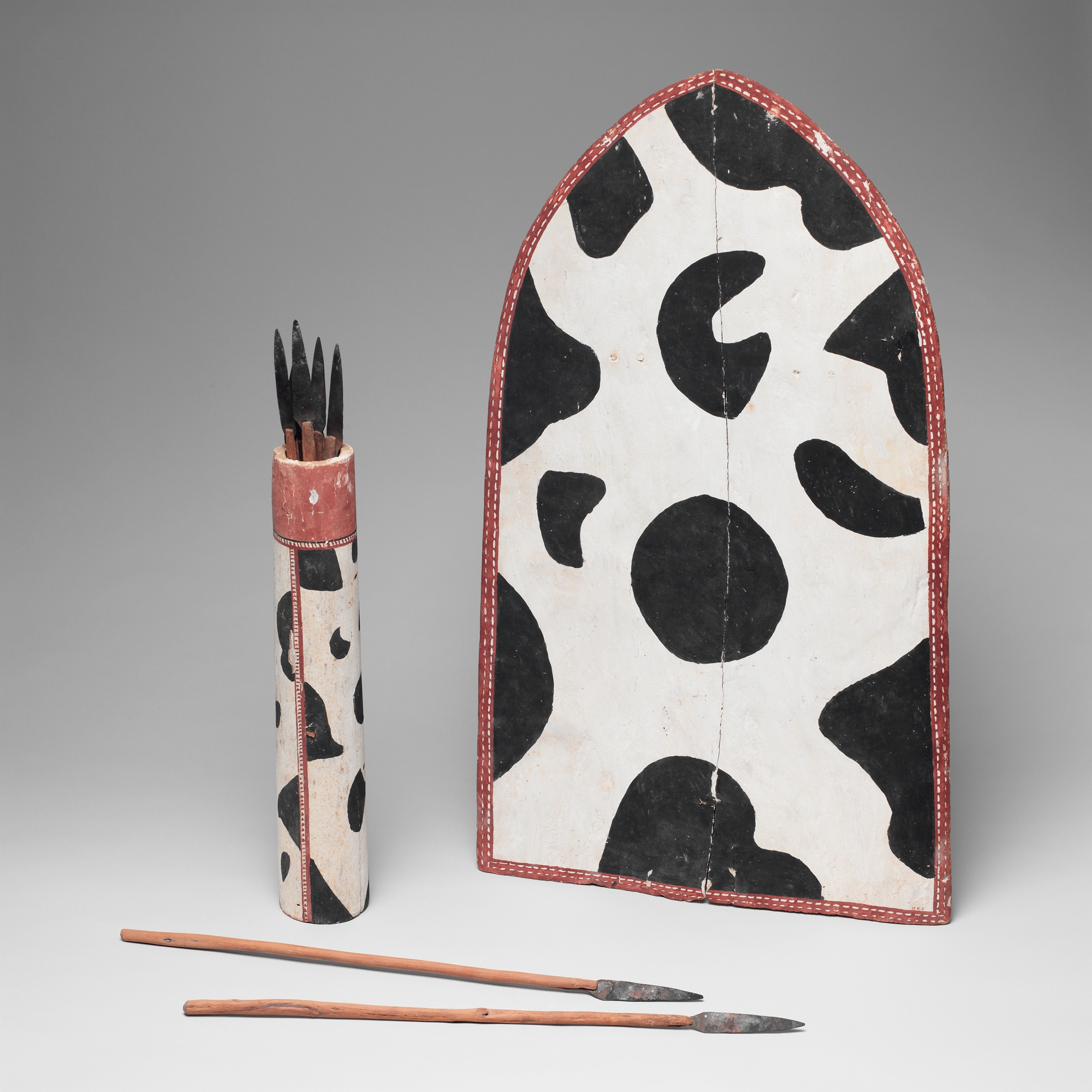
Model shield, spear case and spears from Asyut. The Metropolitan Museum of Art: 17.9.3-.11 (https://www.metmuseum.org/art/collection/search/590949).
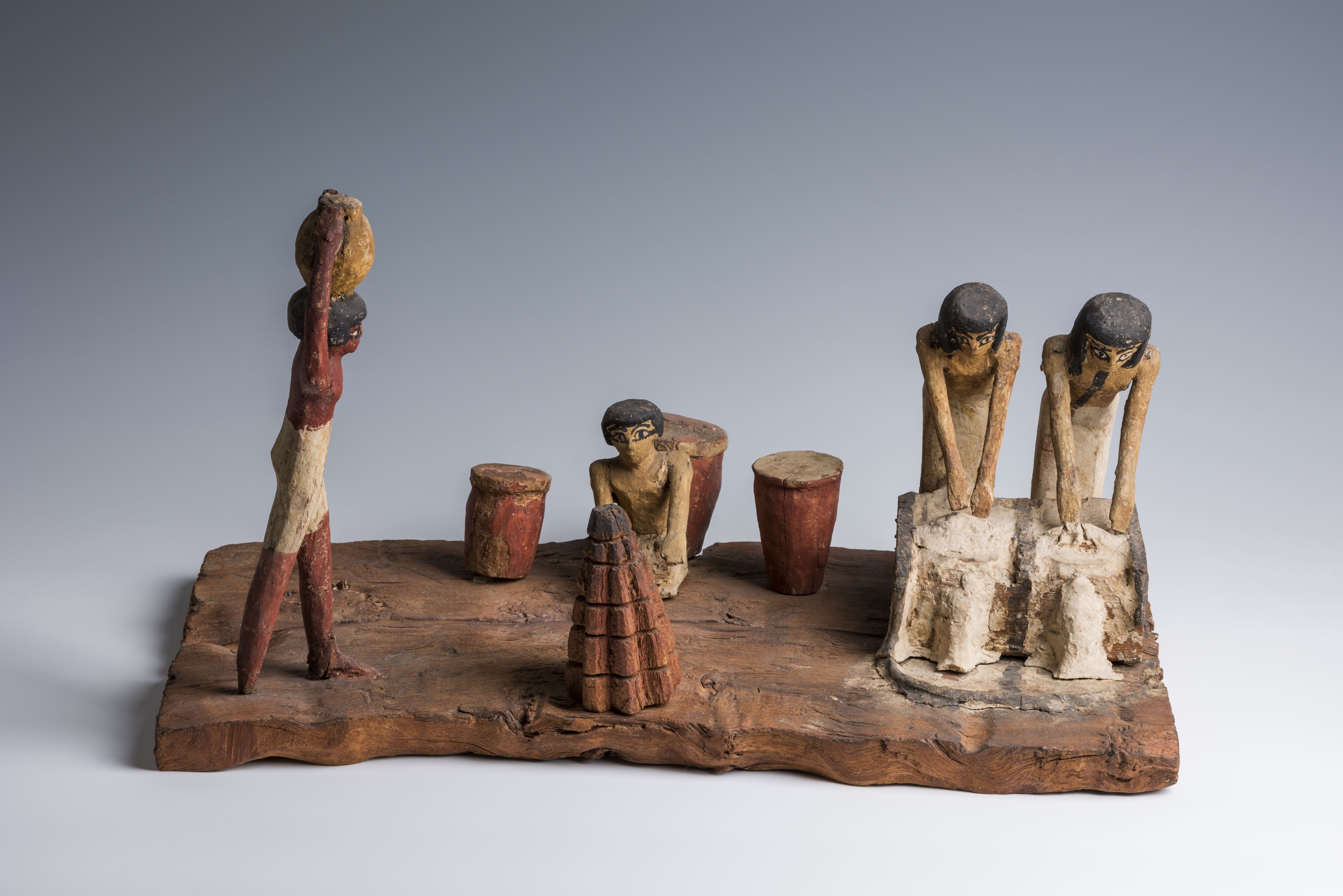
Model of bread production from the tomb of Minhotep at Asyut. Museo Egizio: S. 8789 (http://collezioni.museoegizio.it/en-GB/material/S_8789/).
Lifting the veil: Female Social Power in Early Egypt (c. 3080-2180 BCE)
Sue Kelly
This project aims to transform existing narratives on women’s roles from Early Dynastic and Pyramid Age Egypt (c. 3080–2181 BCE) by demonstrating female involvement, influence and impact in social power domains and the socioeconomic structure of the early State.
The project incorporates theoretical aspects, ancient inscriptions, and historical evidence to reveal women’s agency and engagement in working relationships and associations within the State’s economic, ideological, and political domains. Theoretical and gender studies are increasingly challenging the once static male-centric hierarchical and female domestic narratives of ancient Egyptian society and State, which are the remnants of Western and Eurocentric modelling of the late 19th and early 20th centuries.
Adopting an interdisciplinary approach that integrates sociological frameworks to the indigenous culture of ancient Egypt will advance the debates around social complexity and the emerging State.
The project’s intended goal is to demonstrate women’s contributions in conjunction with different types of power, heterarchical structures, and the interactions of networks that are integral to ancient and modern states. The importance of accumulating evidence of positive female references from antiquity is vital to deconstruct the legitimisation of women’s oppression still current in many modern patriarchal societies.
Funding period
November 2021 – November 2022
Funding source
Covid Research Fellowship, Macquarie University

Recording pottery on site, Dendera
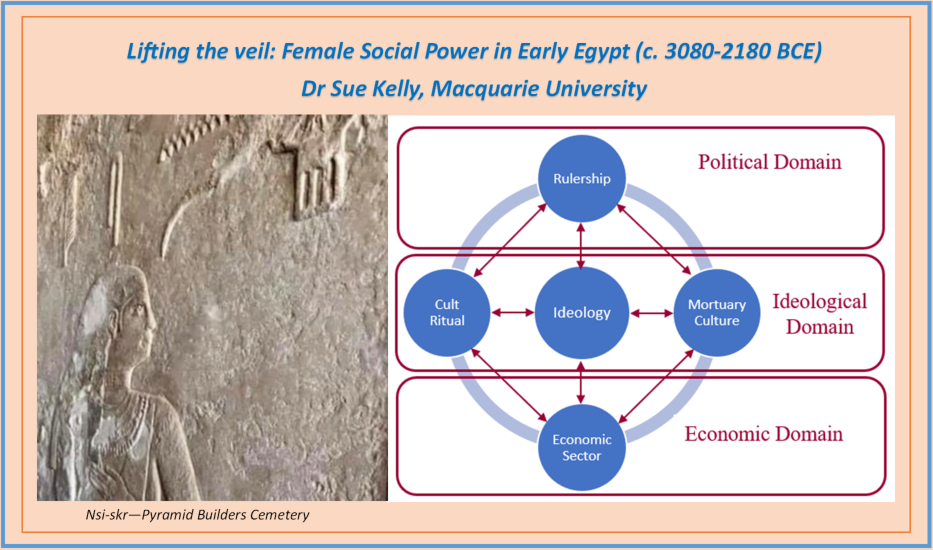
Bibliography
Kelly S. A. (2019), “Women’s Work in the Early Dynastic Period”, Prague Egyptological Studies XXIII, pp. 92–105.
Macquarie Theban Tombs Project
Collaborators: Boyo Ockinga, Susanne Binder, Karin Sowada, Heike Behlmer (Göttingen University), Malcolm Choat, Camilla Di Biase-Dyson
The ongoing Macquarie Theban Tombs Project has been working in four New Kingdom tombs located in Dra Abu el-Naga at the northern end of the Theban necropolis since 1991: TT 148 (3rd Priest of Amun, Amenemope, Dynasty 20), TT 233 (Royal Scribes Saroy and Amenhotep/Huy, Dynasty 19), TT 147 (Scribe and Cattle Counter Neferrenpet, Dynasty 18) and TT 149 (Royal Scribe Amenmose, Dynasty 20).
Apart from TT 148, very little was known of these poorly preserved tombs and their owners, and the project has succeeded in retrieving and recording significant new epigraphic and archaeological data that illuminate the family backgrounds and careers of the owners, their role in the administration of their times, as well as funerary beliefs and practices.
Reconstructing the history of the use of the tombs has also been a focus, their systemic reuse as burial sites from Dynasties 21 to 26, and in particular their non-systemic use as dwellings in the Late Antique / Coptic Period when TT 233 and TT 147 were part of the earliest phase of a monastic complex that developed into the nearby monastery of St Paul at Deir el Bakhit.
Funding period: 1991 – 2024
Funding source: Australian Research Council; Macquarie University Research Development Grants; Rundle Foundation for Egyptian Archaeology; Department of Ancient History, Macquarie University.

Neferrenpet and his wife offering to Amun at the Beautiful Festival of the Valley, Theban Tomb TT 147 (photo by Leonie Donovan)
Coptic / Late Antique remains in the courtyard of Theban Tomb TT 233.
Bibliography
Books and Book Chapters
Ockinga, B.G., “An ‘Appeal to the Living’ from the Tomb of Saroy, Dra Abu el Naga (TT 233)” in Janice Kamrin, Miroslav Bárta, Salima Ikram, Mark Lehner, Mohamed Megahed (eds.), Guardian of Ancient Egypt: Essays in Honor of Zahi Hawass. Prague: Charles University, Faculty of Arts, 2020, 1133-1144.
Ockinga, B.G., “A son welcomes his father to the netherworld: an unusual funerary text from TT 233” in Marc Brose, Peter Dils, Franziska Naether, Lutz Popko und Dietrich Raue (eds.), En détail – Philologie und Archäologie im Diskurs. Festschrift für Hans-Werner Fischer-Elfert. Zeitschrift für ägyptische Sprache und Altertumskunde Beihefte 7/2, Berlin: De Gruyter, 2019, 815 – 829.
Ockinga, B.G., “What the ‘Noble Traveller’ got up to in Thebes: Lord Belmore’s ‘Herculean undertaking’ in TT 148” in Neil Cooke (ed), Journeys Erased By Time. The rediscovered footprints of travellers in Egypt and the Near East, Oxford: Archaeopress, 2019, 157 – 172.
Ockinga, B.G., "As god endures, there is no misstatement in my utterance!" The context of the assertions of truthfulness in the biography of Saroy (TT233) in Todd Gillen (ed), (Re)productive Traditions in Ancient Egypt,Liège, 2017, 127-148.
Sowada , K. and S.J. Wimmer, “Two Iron Age IA amphoriskoi from southern Canaan in a Twentieth Dynasty Theban Tomb”, in: Camilla Di Biase-Dyson and Leonie Donovan (eds.), The cultural manifestations of religious experience: studies in honour of Boyo G. Ockinga. ÄAT 85, Münster: Ugarit-Verlag, 2017, 71-83.
Choat, M., “Posidonios and the monks of TT233 on Dra Abu el-Naga” in Paola Buzi, Camplani, Alberto and Federico Contardi (eds.), Coptic society, literature and religion from late antiquity to modern times: proceedings of the tenth international congress of Coptic studies, Rome, September 17th-22nd and plenary reports of the ninth international congress of Coptic studies, Cairo, September 15th-19th, 2008. OLA 247, Leuven, Belgium: Peeters Publishers, 2016, 749-754.
Ockinga, B.G., "Subversion oder Loyalität? Nochmal zur Frage der Beziehung zwischen den Hohepriestern Thebens und dem König in der späten Ramessidenzeit" in Horst Beinlich (ed.), Die Männer hinter dem König. 6. Symposion zur ägyptischen Königsideologie. Iphofen Knauf-Museum 16.-18. Juli 2010, Wiesbaden: Harrassowitz, 2012, 91-106.
Ockinga, B.G., "A Royal Ritual Text in TT 233" in Mark Collier and Stephen Snape (eds.), Festschrift for Kenneth A. Kitchen,Liverpool: Rutherford Press, 2011, pp. 99–113
Behlmer, H. and M. Underwood, “Coptic Textual Finds from the Macquarie University Excavations at Dra Abu al-Naga (TT223)” in: Gawdat Gabra; Hany N. Takla (eds.), Christianity and Monasticism in Upper Egypt: Volume 2: Nag Hammadi-Esna, Cairo: American University in Cairo Press 2010, 7-19.
Ockinga, B.G., The Tomb of Amenemope (TT 148) Vol. 1 Architecture, Texts and Decoration ACE Reports 27, Oxford: Aris & Phillips, 2009, pp. 149 + 110 plates
Ockinga, B.G., "Use, Reuse, and Abuse of 'Sacred Space': Observations from Dra Abu el-Naga" in Peter Dorman and Betsy Bryan (eds.), Sacred Space and Sacred Function in Ancient Thebes, Chicago: OIP, 2007, 139–162.
Ockinga, B.G., "Osiris and the Great Serpent in TT 148: Innovations in Funerary Iconography and Texts in the 20th Dynasty" in Hans-Werner Fischer-Elfert/Karola Zibelius-Chen (eds.): "Von reichlich ägyptischem Verstande". Festschrift für Waltraud Guglielmi = Philippika VIII. Marburger altertumskundliche Abhandlungen, Wiesabden: Harrassowitz, 2006, 91–102.
Ockinga, B.G., "New Light on the Cairo Statues of Saroy" in Mamdouh Eldamaty and Mai Trad (eds.), Egyptian Museum Collections around the World. Studies for the Centennial of the Egyptian Museum, Cairo, ed. by, Cairo: SCA Press, 2002, Vol. II, 873-884.
Journal Articles
Ockinga, B.G. and H.-W. Fischer-Elfert, “An Amuletic Papyrus from Theban Tomb 233 and the Four Akh-spirits”, in Zeitschrift für Ägyptische Sprache und Altertumskunde 147 (2020), 34 – 46.
Ockinga, B.G. and S. Binder, “The Tomb of Amenmose (TT149) and the title of sS wdHw : preliminary results of current work in Dra Abu el-Naga”, in Bulletin of the Australian Centre for Egyptology 26 (2016-2018), 53 – 70.
Sowada, K., “Ceramics from the Main Burial Apartments of Theban Tomb 148 (Twentieth Dynasty)”, in Bulletin de ceramique égyptienne 27 (2017), 63-80.
Ockinga, B.G., "Designed to impress: uncovering the courtyard of Theban Tomb 149" in Egyptian Archaeology 47 (2015), 40 ff.
Ockinga, B.G. and S. Binder, “Macquarie Theban Tombs Project: 20 Years in Dra Abu el Naga” Ancient History 39 (2009) 205 -247 (published 2012)
Ockinga, B.G., "TT 147 – Observations on its Owners and Erasures" in Bulletin of the Australian Centre for Egyptology 15 (2004) 121–129
Ockinga, B.G., "Excavations at Drac Abu el-Nagac: Report on the Nov-Dec 2000 and Jan-Feb 2002 Seasons" in Bulletin of the Australian Centre for Egyptology 13 (2002), 135-147.
Ockinga, B.G., "Theban Tomb 233 – Saroy regains an Identity" in Bulletin of the Australian Centre for Egyptology 11 (2000) 103 – 113, Pls. 22-24.
Ockinga, B.G., "Macquarie Theban Tombs Project TT 148 the Tomb of Amenemope. Report on the 1994/1995 and 1996/1996 Seasons" in Bulletin of the Australian Centre for Egyptology 7 (1996) 65-73.
Ockinga, B.G., "Another Ramesside Attestation of Usermont, Vizier of Tutankhamun" in The Bulletin of the Australian Centre for Egyptology 5 (1994), 61-66.
Ockinga, B.G., "Macquarie University Theban Tombs Project: TT 148 Amenemope: Preliminary Report on 1991/92 and 1992/3 Seasons" in The Bulletin of the Australian Centre for Egyptology 4 (1993), 41–50.
Nilotic History on the Rocks: The Macquarie University Mission to El-Hosh
Collaborators: Linda Evans, Fred Hardke, Wouter Claes (Royal Museums of Art and History, Brussels)
We are investigating El-Hosh, one of the most extensive Nilotic rock art sites in Upper Egypt. The petroglyphs at El-Hosh include a dazzling array of boats, wild animals, and enigmatic abstract signs scattered over a wide area.
Recording and interpretation of this rich artistic medium is providing new insights into the early history and cultural development of Nilotic communities, significantly increasing our knowledge of the Egyptian Palaeolithic, Epipalaeolithic and Predynastic horizons (circa 13000 to 3000 BC), for which documentary evidence is still fragmentary.
Funding period
January 1, 2019 - December 31, 2022
Funding source
Macquarie University Research Seeding Grant
Link
https://www.brusselsmuseums.be/en/museums/royal-museums-of-art-and-history
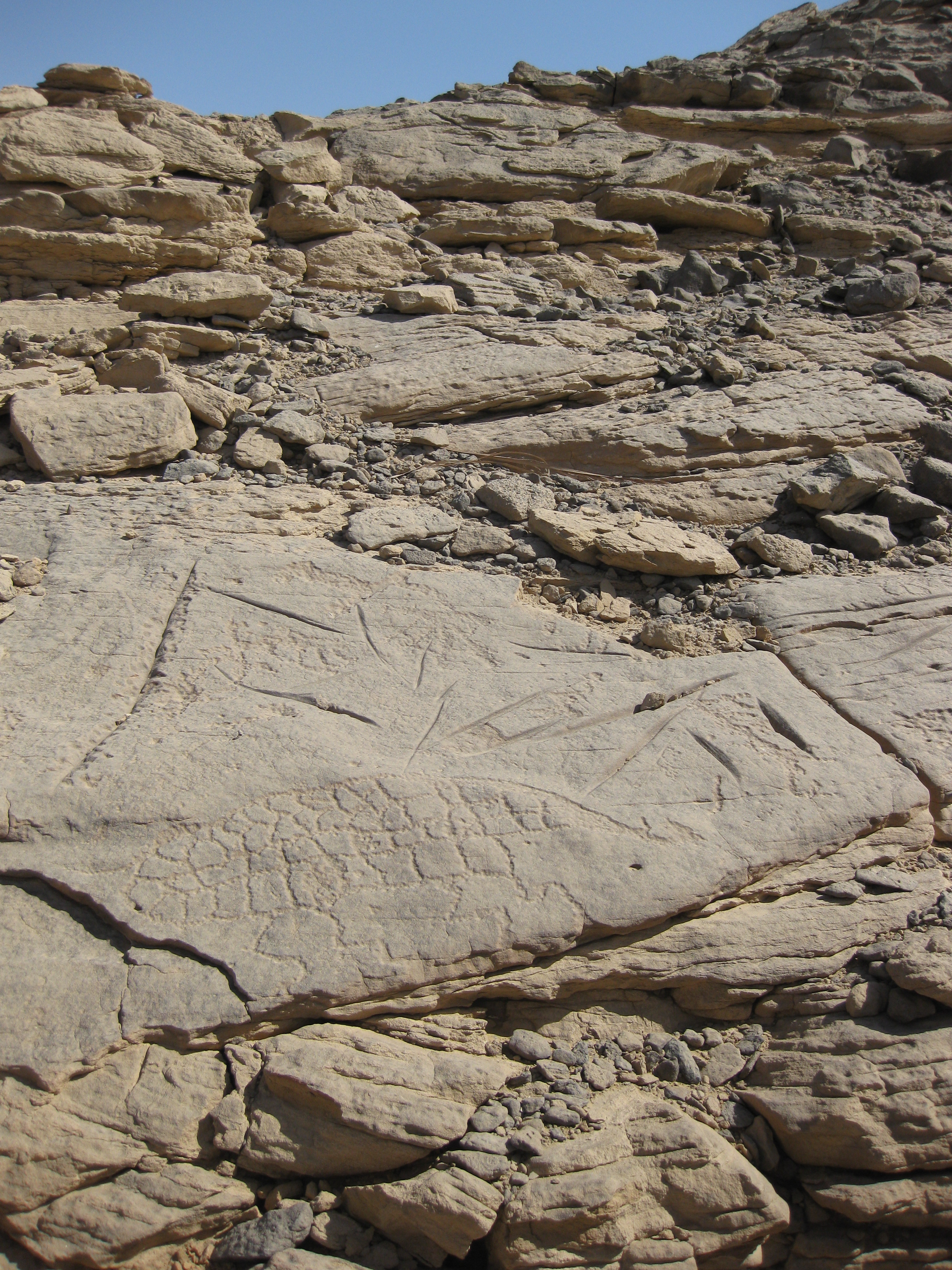 Rock art panel, el-Hosh (F. Hardtke and W. Claes)
Rock art panel, el-Hosh (F. Hardtke and W. Claes)
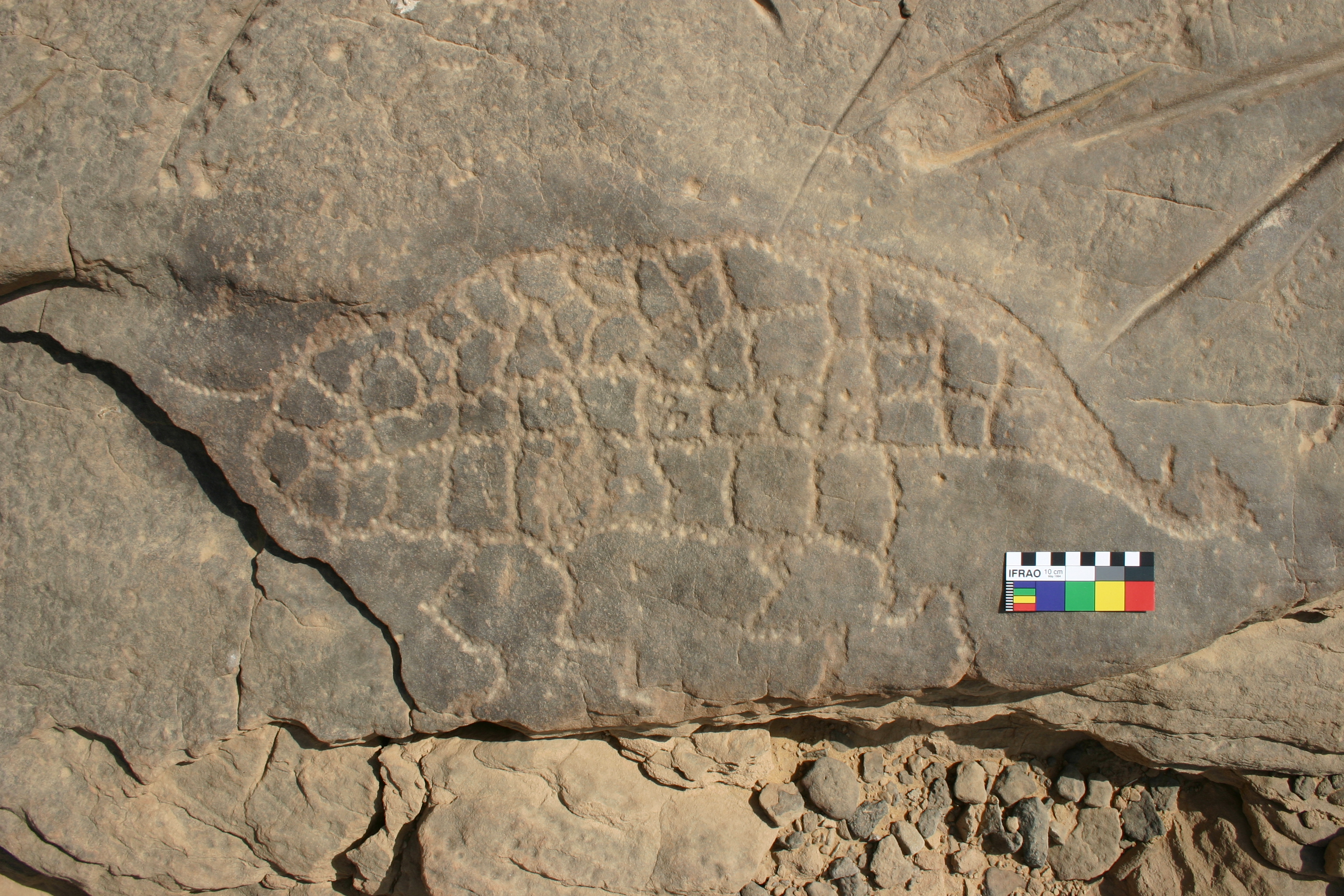 Figure of a chameleon, el-Hosh (F. Hardtke and W. Claes)
Figure of a chameleon, el-Hosh (F. Hardtke and W. Claes)
Bibliography
Evans, L., Hardke, F., Corbin, E., and Claes, W., Camouflaged chameleons: A new discovery at the Egyptian site of el-Hosh, Archaeological and Anthropological Sciences 12.8 (2020). https://doi.org/10.1007/s12520-020-01125-y
Pyramids, power and the dynamics of states in crisis
Karin Sowada (Macquarie University)
The Project aims to transform existing narratives on the impact of Egypt in the eastern Mediterranean during the Pyramid Age of the Old Kingdom (c. 2686-2200 BC), by demonstrating the influence of large state entities as drivers of societal change in the ancient world. Using archaeological, historical and new scientific data, the Project’s research design focuses on the role of economic interests, statecraft and leadership in the face of climate change and the movement of people.
The Project builds on Sowada’s seminal work published in 2009 (see below), through fieldwork and scientific collaborations on four continents to answer fresh research questions about Egypt and its north-eastern neighbours during the third millennium BC. Foremost among the project partners is the Museum of Fine Arts in Boston, which holds a large collection of material from excavations at Giza conducted early last century.
Funding period
July 2017 – July 2022
Funding source
Australian Research Council Future Fellowship Project (Grant FT170100288)
Karin Sowada drawing a pot
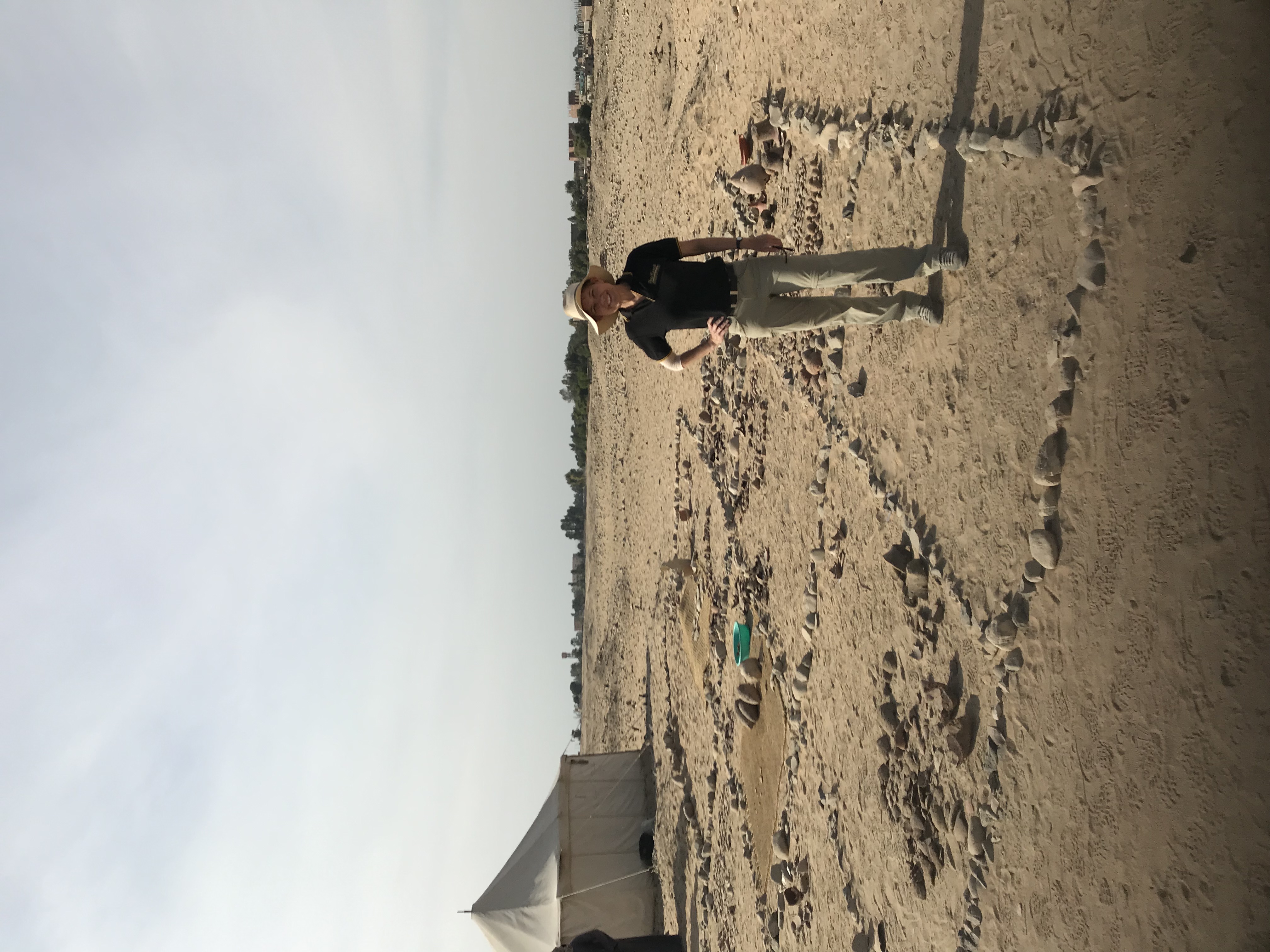
Karin Sowada in the field at Dendera, working on pottery.
Bibliography
K. Sowada, R. Newman, F. Albarède, G. Davis, M.R. Derrick, T.D. Murphy, D. Gore, Analysis of queen Hetephere’s bracelets from her celebrated tomb in Giza reveals new information on silver, metallurgy and trade in Old Kingdom Egypt, c. 2600 BC, Journal of Archaeological Science: Reports (2023) available on open access doi.org/10.1016/j.jasrep.2023.103978
K. Sowada, M. Ownby, M. Bárta, ‘The Origin of Imported Jars from Sixth Dynasty Abusir: New light of Egyptian-Levantine Relations’, Bulletin of the American Schools of Overseas Research 386 (2021), 221–236.
K. Sowada, ‘Perspectives on Egypt in the Southern Levant in light of the high EBA Chronology’, ed. S. Richard, New Horizons in the Study of the Early Bronze III and Early Bronze IV in the Levant (Eisenbrauns: Philadelphia, 2020), 149–168.
K. Sowada, M. Ownby, A. Wodzińska, ‘The Petrography of Levantine Combed Vessels from early Old Kingdom Giza’, Levant 51/1–2 (2019), 197–214. Available on open access https://www.tandfonline.com/doi/full/10.1080/00758914.2019.1664197
K. Sowada, with a contribution by P. Grave, Egypt in the Eastern Mediterranean during the Old Kingdom: an Archaeological Perspective (Orbis Biblicus et Orientalis Series 237: Fribourg, 2009).
Qubbet el-Hawa Research Project
Martin Bommas
Qubbet el-Hawa (engl. dome of the winds) is located in West-Aswan. From the Old Kingdom onwards, the area served as a cemetery for the administrative elite of the Island of Elephantine, Egypt’s border with Nubia and gateway into Central Africa. Further to the already well-understood and published Old and Middle Kingdom rock-cut tombs, including the famous burial places of Kharkhuf, Sarenput I and II, the award-winning Qubbet el-Hawa Research Project (QHRP) investigates the necropolis below the 1st and 2nd terrace tombs discovered in 2015. Up until today, the project discovered nine mastaba tombs (Site C) and three causeways, including the causeways of the tombs of Sarenput I (QH 36, Site D) and Sobekhotep (QH 90, Site D) which have been sought by scholars for more than 100 years.
In addition to excavations, the joint Egypt Exploration Society/ Macquarie University QHRP focuses on the understanding of ancient Egyptian cemetery infrastructures and the role memory played in shaping ‘cities of the dead’. Crucial to the understanding of patterns of social mobility, intergeneration rise within families buried at the slopes of Qubbet el-Hawa during the Old and Middle Kingdom forms another research topic, informed by the contemporary archaeological evidence known from Elephantine. QHRP is one of the rare missions working in Egypt which permanently integrates pottery and scientific analysis as part of its vision of multidisciplinary archaeological fieldwork and research.
Funding period
2015- December 2023
Funding sources
EES fieldwork grants, University of Birmingham research funds, Macquarie University start-up funding
Qubbet el-Hawa, view from the southeast
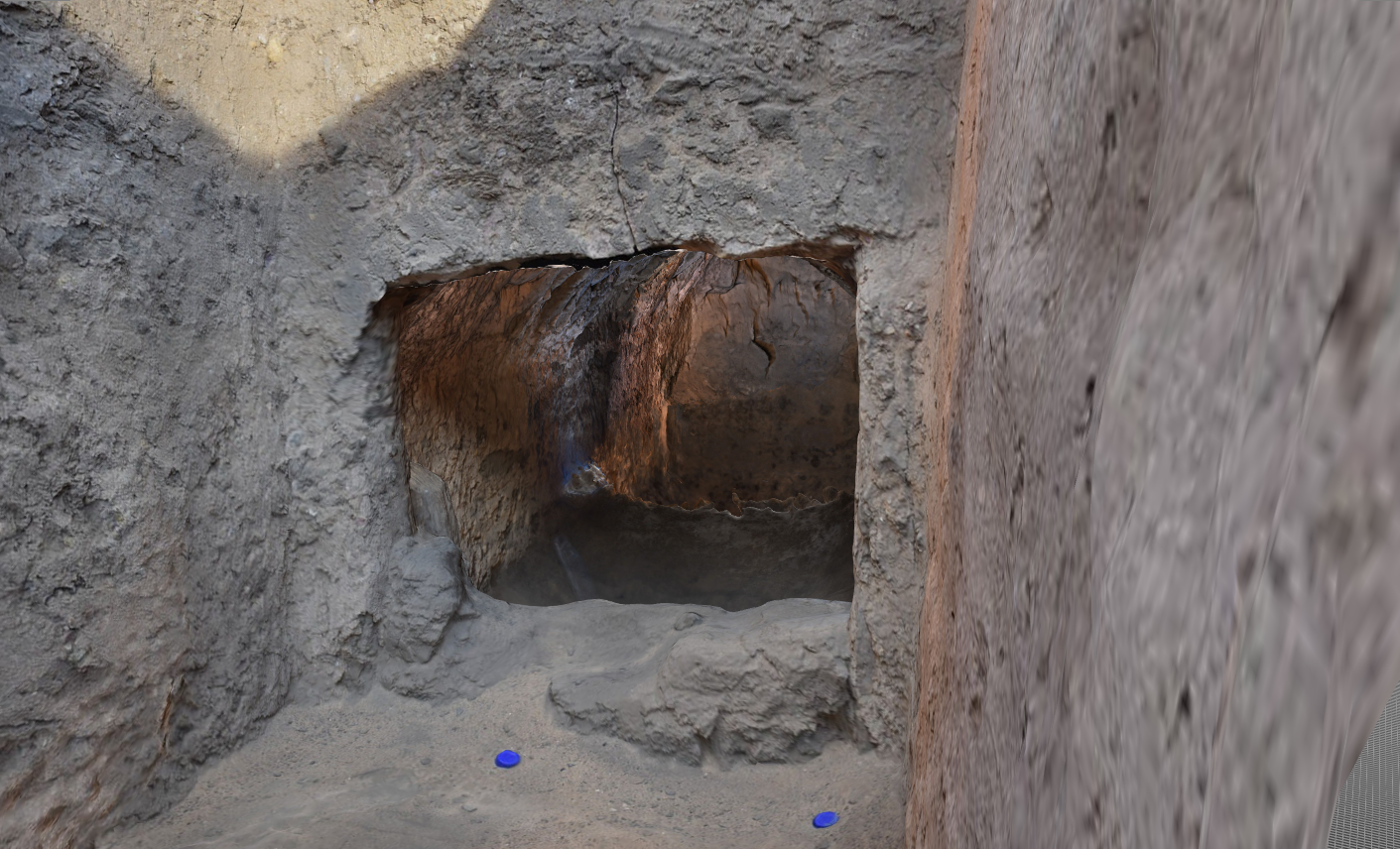 Interior of shaft tomb 4B02 including the burial chamber, based on 3D scan (https://mq.pedestal3d.com/r/DILMYfkpqw)
Interior of shaft tomb 4B02 including the burial chamber, based on 3D scan (https://mq.pedestal3d.com/r/DILMYfkpqw)
Bibliography
Bommas, M. 2016. ‘Qubbet el-Hawa, 2016’, Journal of Egyptian Archaeology 102, 23-40.
Bommas, M. 2017. ‘Displaying social movement during the time of Senwosret I’, Egyptian Archaeology 51, 26-29.
Bommas, M. 2020. ‘Qubbet el-Hawa, 2019’, Journal of Egyptian Archaeology 106, 17-36 (incl. ceramic analysis by E. Khalifa)
E. Khalifa/ S. Abd Elrahim, Identification of Vessel Use and Explanation in Production Techniques From the Old to the Middle Kingdom: organic residue analysis, fabric and thermal characterization of pot sherds from Qubbet el-Hawa, Aswan, Egypt, in: Archaeometry 62.6, 2020, 1115-1129.
Re-excavating and recording Beni Hassan
Collaborators: Naguib Kanawati, Martin Bommas, Linda Evans. Zeinab Hashesh (Beni Suef University), Eman Khalifa (Cairo University, Michael Schultz (Göttingen University), Ashraf Senussi (MOTA), Sameh Shafik (Higher Institute for Tourism and Hotel Management, Luxor), Ahmad Soleiman, Naguib Victor
Work in the important site of Beni Hassan has been conducted by a number of scholars, the last of whom was Newberry, whose publications of the decorated tombs (1890-1894) remained until recently the most widely used. The unusuable decorated burial chamber of Baquet ll has been pub;ished. The current project, which started in 2010, is in progress. It aims at re-excavating, recording and publishing the decorated tombs and a selected number of the undecorated ones, which exhibit important architectural features.
In addition to full commentaries, the planned publications include architectural drawings, line drawings of wall scenes and inscriptions and coloured photographs. These tombs show magnificent architectural plans, some with spectacular porticos and pillared chapels. The wall scenes, which have retained a great deal of their colours, depict many daily life activities as well as important events in the lives of the owners. The re-clearance of the burial shafts were most surprising, occasionally revealing large burial apartment, with skeletal remains, funerary objects and wall paintings showing animate figures of humans and animals.
Work has been completed in the tombs of Amenemhat, Khnumhotep I, Khnumhotep II, Baqet III and Khety, in addition to two decorated Old Kingdom tombs. Work is currently in progress in the tombs of Remushenti, Baqet I and Baqet II, as well as the undecorated tombs Nos 18 and 32.
Funding period
2016 to 2023
Funding sources
Australian Research Council, the Macquarie University Research Grants and the Rundle Foundation for Egyptian Archaeology.
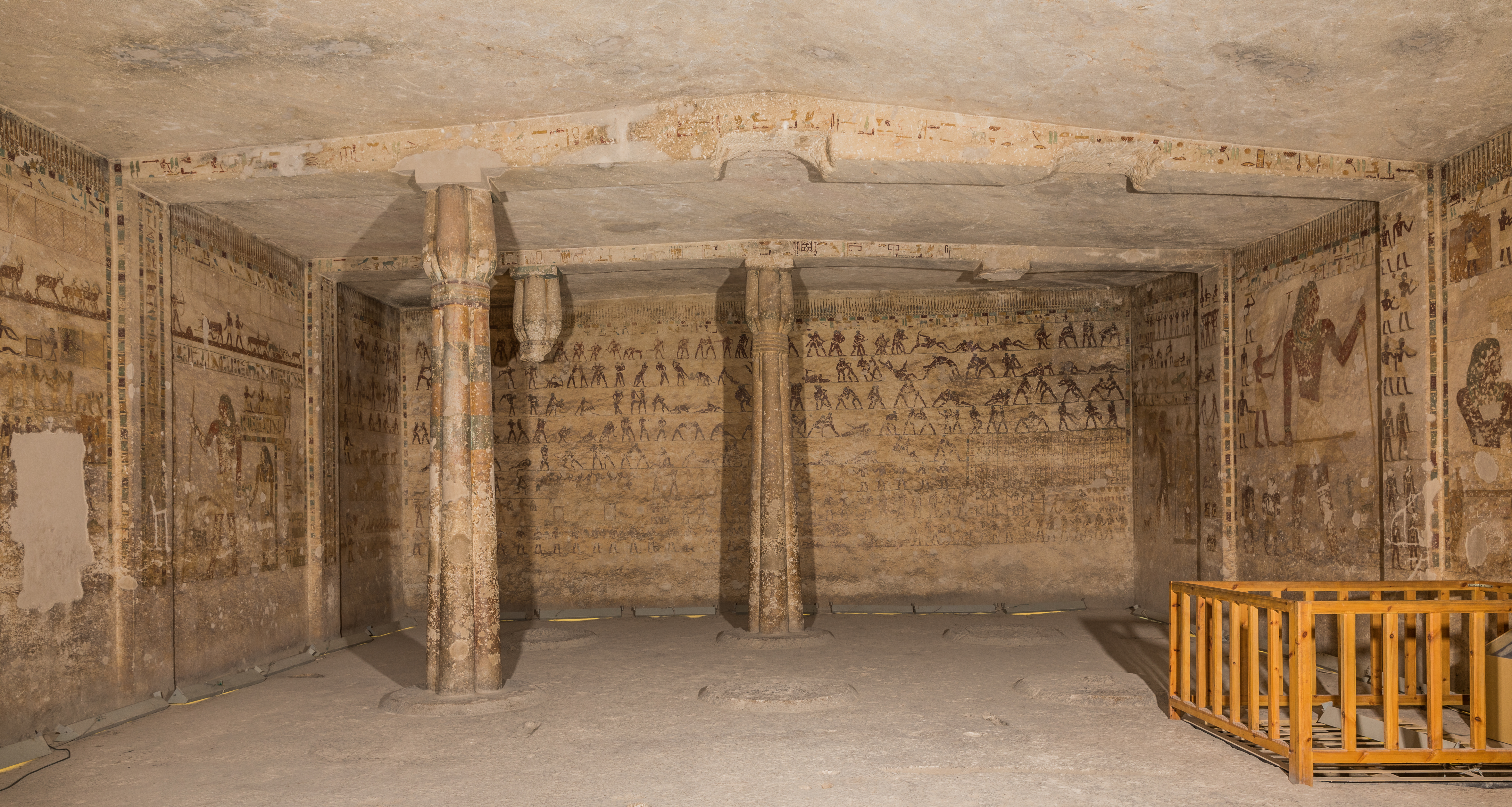
Beni Hassan, general view from the Chapel of Khety
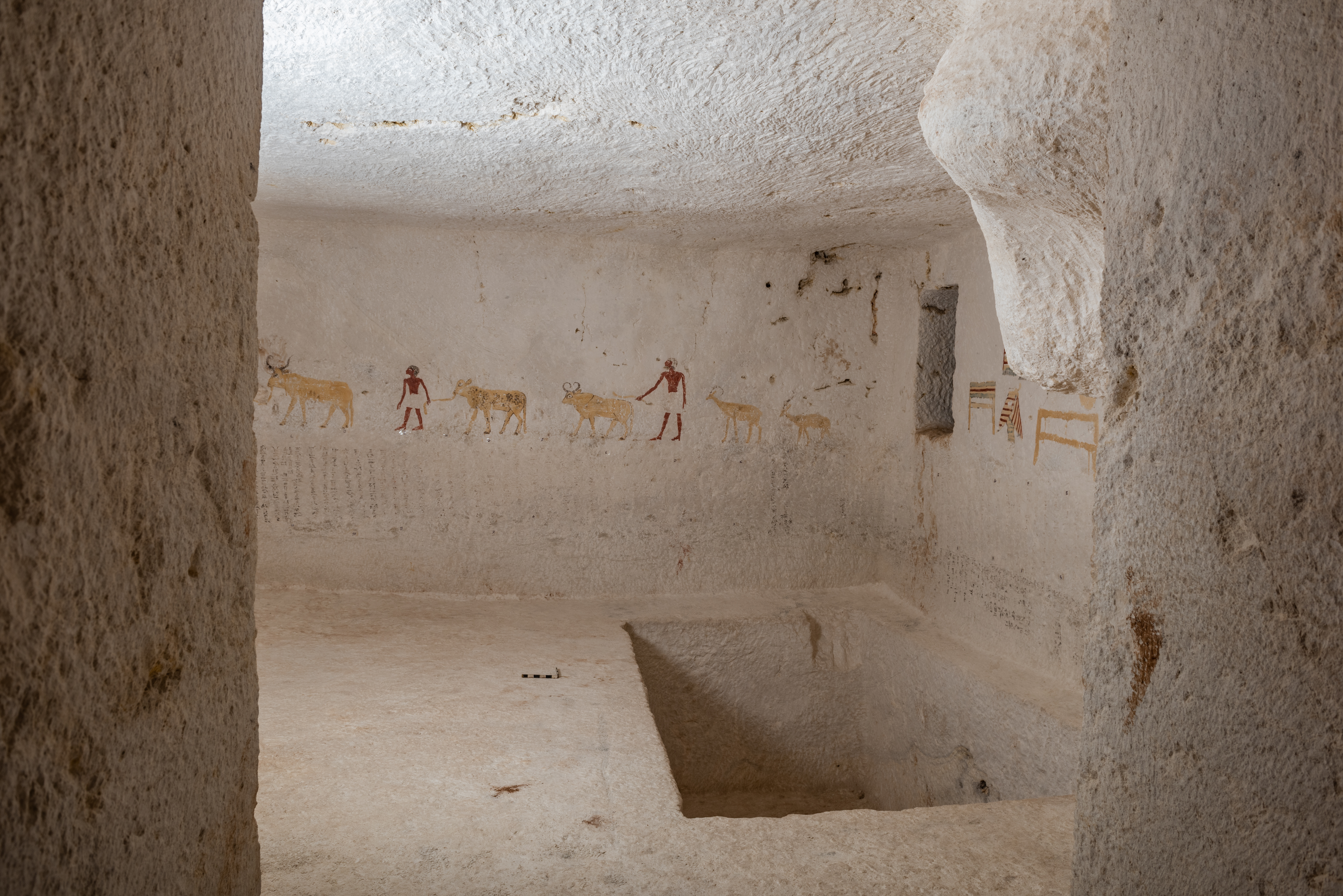 Beni Hassan, Burial chamber of Baqet II
Beni Hassan, Burial chamber of Baqet II
Bibliography
Books
Kanawati, N. and Evans, L., with a chapter by Mourad, A.L., Beni Hassan, vol. I: The Tomb of Khnumhotep II (Oxford, 2014).
Lashien, M., with chapters by Mourad, A.L. and Senussi, A., Beni Hassan, vol. II: Two Old Kingdom Tombs (Oxford, 2016).
Kanawati, N. and Evans, L., with a chapter by Mourad, A.L., Beni Hassan, vol. III: The Tomb of Amenemhat (Oxford, 2016).
Kanawati, N. and Evans, L., Beni Hassan, vol. IV: The Tomb of Baqet III (Oxford, 2018).
Lashien, M., and Mourad, A.L., Beni Hassan, vol. V: The Tomb of Khnumhotep I (Oxford, 2019).
Kanawati, N. and Evans, L., with a chapter by Hashesh, Z. and Schultz, M., Beni Hassan, vol. VI: The Tomb of Khety (Wallasey, 2020).
Book chapters
Kanawati, N., ‘Mortuary culture in the provinces: the example of Beni Hassan’, in: Y. Tristant and Ryan, E. M. (eds.), Death is only the beginning: Egyptian funerary customs at the Macquarie Museum of Ancient Cultures, Oxford, 2017, 56-65.
Kanawati, N., ‘Papyrus thickets in the Old and Middle Kingdoms, with reference to the scenes in the tombs of Baqet III and Khety at Beni Hassan’, in: C. Di Biase-Dyson, and L. Donovan (eds.), The Cultural Manifestations of Religious Experience: studies in honour of Boyo G. Ockinga., Münster, 2017, 119-132.
Journal articles
Kanawati, N., ‘Ritual marriage alliances and consolidation of power in Middle Egypt during the Middle Kingdom’, in: Etudes et Travaux, 30 (2017), 267-288.
Kanawati, N., Bommas, M. and Khalifa, E., ‘Governor Baqet II at Beni Hassan: Security in Death’, in: Egyptian Archaeology, 59 (2021), 37-41.
The Ties that Bind. Negotiating Foreign Relations in the Second Millennium BC’
Anna-Latifa Mourad
The project The Ties that Bind assesses networks of contact and exchange. It questions how foreign relations emerge and how they are maintained, despite political turnovers and socio-cultural shifts. To answer these, it examines a pivotal period in which intricate networks developed alongside significant transformations: the Middle Bronze Age, which roughly correlates with the Egyptian Middle Kingdom and the Second Intermediate Period.
This period witnessed the rise and fall of several powers across Egypt and the Near East, population movements and technological advancements. However, it also coincided with the punctuated yet continuous growth of a dynamic network that resulted in the first known ‘International Age’ of the Late Bronze Age. The project thus aims to identify the processes through which ancient Egyptian and Near Eastern communities negotiated and maintained foreign relations across this period.
To do this, it focusses on an investigation of developments in key sites in ancient Egypt as case studies, including Beni Hassan and Tell el-Dabˤa. It applies an interdisciplinary approach that combines archaeology, ancient history, and current anthropological and sociological theories on transformation as well as cross-border relations. Ultimately, the project will propose new insights into how prosperous networks emerged and persisted across changing socio-cultural landscapes.
Funding period
October 2019–December 2022
Funding source
Macquarie University Research Fellowship
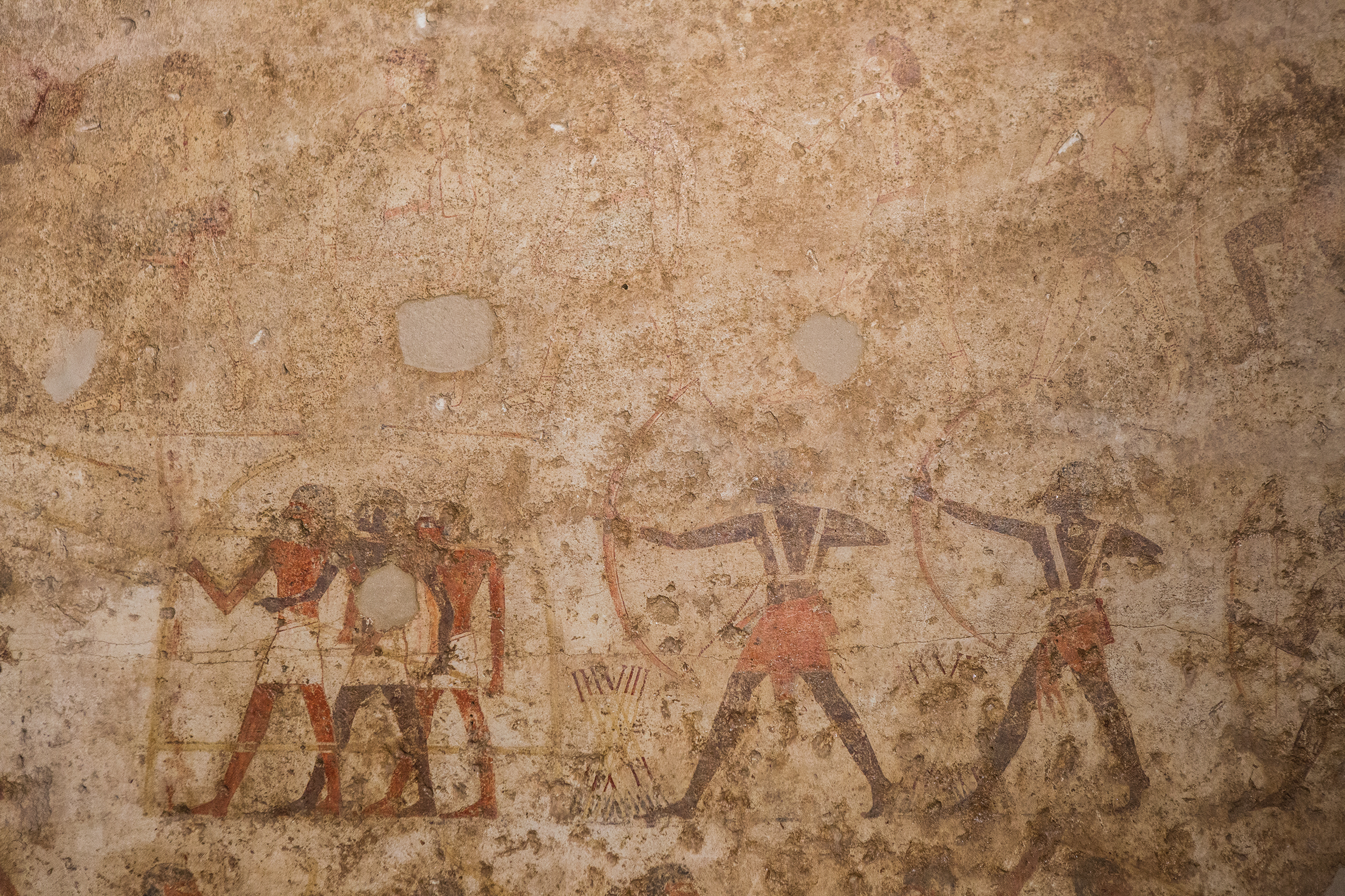 Detail from the tomb of Khnumhotep I, Beni Hassan (Ahmed Suleiman; copyright ACE).
Detail from the tomb of Khnumhotep I, Beni Hassan (Ahmed Suleiman; copyright ACE).
Bibliography
Mourad, A.-L. 2020. Foreigners at Beni Hassan: Evidence from the Tomb of Khnumhotep I (No. 14). BASOR 384: 105–132.
Mourad, A.-L. 2021. The Enigma of the Hyksos, Volume II: Transforming Egypt into the New Kingdom: The Impact of the Hyksos and Egyptian-Near Eastern Relations. Contributions to the Archaeology of Egypt, Nubia and the Levant 10. Wiesbaden: Harrassowitz.
Mourad, A.-L. 2021. Transforming Egypt into the New Kingdom: The Movement of Ideas and Technology across Geopolitical, Cultural and Social Borders. In M. Bietak and S. Prell (eds.), The Enigma of the Hyksos, Volume IV: Changing Clusters and Migration in the Near Eastern Bronze Age, 457-476. Contributions to the Archaeology of Egypt, Nubia and the Levant 12. Wiesbaden: Harrassowitz.
Mourad, A.-L. 2021. Strategies of Survival? Change, Continuity and the Adaptive Cycle across the Middle to Early Late Bronze Age at Tell el-Dabˤa, Egypt. Journal of Anthropological Archaeology 64: 101367.
Thinking in Ancient Egypt
Camilla Di-Biase Dyson
This project takes a deep dive into how we can trace ancient thought-processes based on ancient Egyptian data. Drawing on evidence from texts, images and objects, manuscripts and spaces, this project charts new territory by drawing on the insights that cognitive science, metaphor studies, semiotics and archaeological theory can bring to our conceptualisation of ancient ways of thinking.
Text-based studies involve studies of metaphor and metonymy, as well as ontologies. Visual studies explore what is chosen to be depicted in a given image or object. Manuscript analyses consider the steps taken (via handwriting, spelling and style) to compose the text and spatial studies engage with the creation and alteration of the built and natural environment.
Bibliography:
Di Biase-Dyson, C.,The Scribe of The Contendings between the Body and the Head—(tTurin CGT 58004 – Cat. 6238): evidence for innovative pedagogical techniques from Ancient Egypt, Journal of Egyptian Archaeology (forthcoming, 2023).
Di Biase-Dyson, C., Building ideas out of wood: what ancient Egyptian funerary 'models' tell us about thought and communication, Cambridge Archaeological Journal33(3) (2023), 413-429.
Di Biase-Dyson, C., The semantics of a parallel reality: what does religion do to metaphor in an Ancient Egyptian context?Metaphor and the Social World. 13(1) (2023), 81-103.
Di Biase-Dyson, C. and Stock, J., Einblicke in den Streit zwischen Leib und Kopf – Eine Neuedition und Textanalyse von tTurin CGT 58004 (Cat. 6238), Zeitschrift fur Agyptische Sprache und Altertumskunde 150(1) (2022), 56-73.
Di Biase-Dyson, C. & Chantrain, G. Metaphors of sensory experience in ancient Egyptian texts: emotion, personality, and social interaction, in Neumann, K. & Thomason, A. (eds.), The Routledge handbook of the senses in the ancient Near East. London: Routledge, 2022, 603-635.
Di Biase-Dyson, C. and Egg, M. (eds), Drawing attention to metaphor: case studies across time periods, cultures and modalities (Figurative Thought and Language; vol. 5), Amsterdam: John Benjamins Publishing Company, 2020.
Di Biase-Dyson, C., Metaphor, UCLA Encyclopedia of Egyptology, in Stauder-Porchet, J., Stauder, A. & Wendrich, W. (eds). Los Angeles: University of California at Los Angeles, 2017, 1-17.
Weidenbach Diary Project
Susanne Binder
When Max Weidenbach's expedition diary was re-discovered in the South Australian Museum in Adelaide in 2013, the project was begun to transcribe, research and translate into English this extensive and significant new primary source on the pioneering royal Prussian expedition to Egypt (1842-45). Weidenbach, a talented draughtsman (b. 1823), was the youngest member of the team travelling with Richard Lepsius (later first professor of Egyptology in Berlin) to record the ancient monuments and inscriptions. Their systematic approach to the documentation distinguishes the ensuing publication of 12 folio volumes with 1000 plates of lithographs from the earlier works of the Napoleonic expedition (1798-1801) and the Franco-Tuscan expedition of Champollion and Rosellini (1828-29): Lepsius, Denkmäler aus Aegypten und Aethiopien (1849-1859).
In collaboration with the Lepsius-Archive at Berlin-Brandenburg Academy of Sciences and Humanities, the publication of the Weidenbach diary – in the original German - has now been completed. A translation into English is in preparation. Initial research on the content of the diary was show-cased at the international Weidenbach Symposium "Max Weidenbach on expedition in Egypt (1842-45) and a life on three continents in Germany, Egypt and Australia" held at Macquarie University in 2017.
2014-2018
Funding sources
Macquarie University Research Development Grant; UA (Universities Australia); DAAD (German Academic Exchange Service); Macquarie University: Outside Studies Program (OSP)
Working on the Max Weidenbach Diary
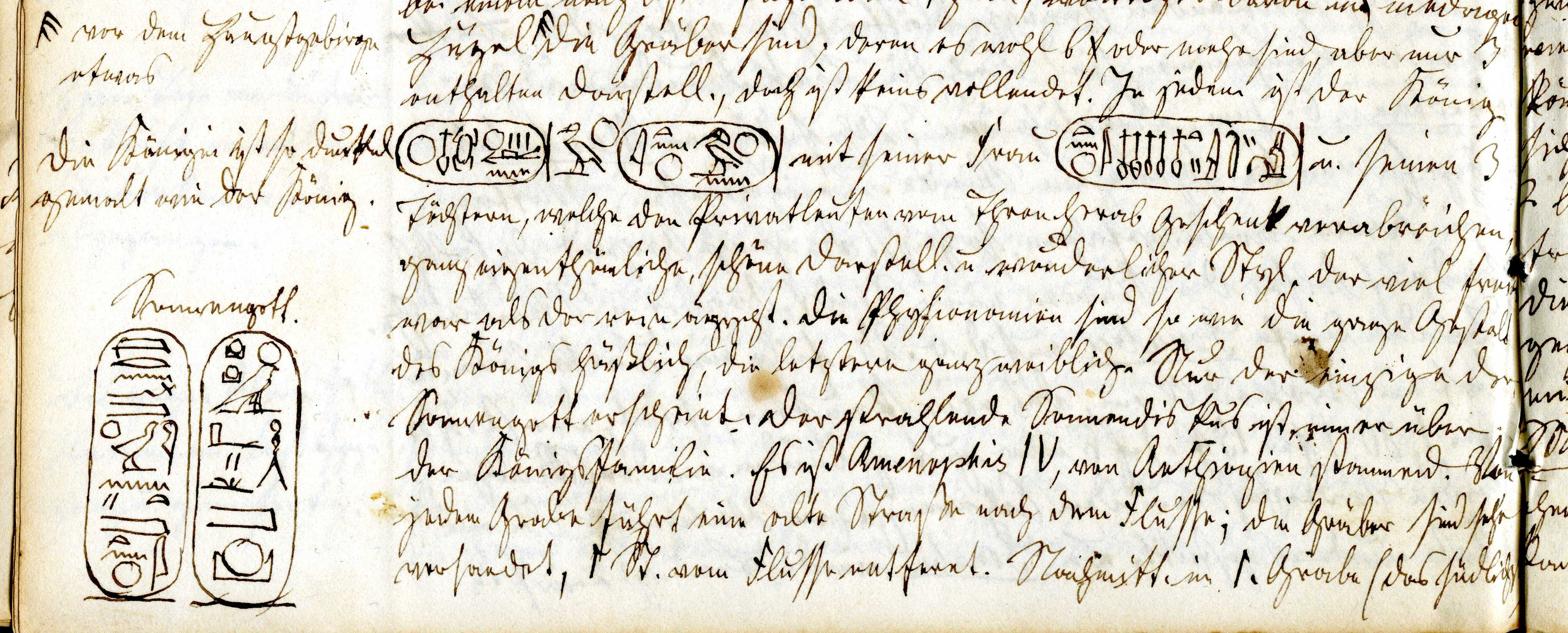
Detail of Weidenbach's diary entry on 7 June 1845 with comments on Amarna.
Bibliography
Binder, S.Auf ins Land am Nil. Das Expeditionstagebuch des Max Weidenbach (1842-1845), Berlin: Kulturverlag Kadmos, 2023.
Binder, S. and B. Ockinga, "The diary of Max Weidenbach: encounters with scholars and travellers during the Prussian scientific expedition to Egypt 1842-45" in: Neil Cooke and Vanessa Daubney (eds), Lost and now found: explorers, diplomats and artists in Egypt and the Near East, Oxford: Archaeopress, 2017, 1-24.
Binder, S. and Boyo Ockinga, "Akhenaten and Amarna through the eyes of Max Weidenbach (1843 and 1845)" in: Jacobus van Dijk (ed.), Another mouthful of dust: Egyptological studies in honour of Geoffrey Thorndike Martin, Orientalia Lovaniensia Analecta 246, Leuven: Peeters, 2016, 43-62.
Binder, S., "The Diary of Max Weidenbach in the South Australian Museum: a new source on the Prussian expedition to Egypt 1842-1845", Bulletin of the Australian Centre for Egyptology 25, 2014, 9-29.

